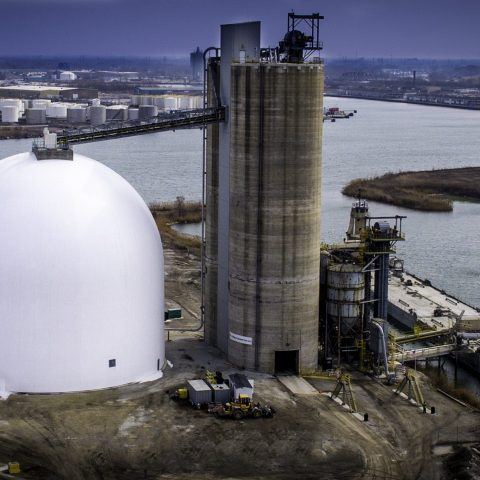Editor’s note: This is an excerpt from a feature published in the November 2016 issue of Dry Cargo International.
Storing cement is a heavy matter. High density often requires soil improvements or deep foundations. Moisture damages product quality. Poor handling can result in compromised or unusable cement.
These were some of the concerns facing by St. Marys Cement as they planned for a storage facility in Chicago. A dome, with its versatile reclaim options, was selected for an existing St. Marys transload facility on Lake Michigan that received via ship cement made at the company’s Charlevoix, Michigan, plant and elsewhere, temporarily stored it, then loaded it onto trucks for transport.
“(St. Marys) was looking for additional storage capacity and an economical solution; domes provide both,” plant manager Randy Pryor said. The project wrapped in January 2016.
Until the new dome was built, the Chicago facility did not have the capacity to store the volume shipped from the Charlevoix plant. The completed dome is allowing St. Marys “to get the dome filled before the lakes freeze over and (they) can’t get ships down there,” Dome Technology operations manager Brent Hardy said.
Total reclaim was another must, and rather than opting for a traditional cement-handling system, St. Marys chose a hybrid system of airslides paired with a Laidig reclaim screw.
“The fluidized screw … will provide a more mechanically reliable solution, as compared to other mechanical reclaim systems. It will also provide for more complete reclaim of stored product compared to other mechanical systems or aerated floors,” Pryor said.
Employees are safer and operations more efficient with the reclaim system St. Marys selected. “The Laidig system greatly reduces (the safety) risk by providing inherent redundancy associated with having two different reclaim methods. Hard-pack areas or dead zones that are not reclaimed by the air-gravity conveyors are broken down and reclaimed by the screw conveyor without putting personnel at risk,” Pryor said.
Increased storage means St. Marys can deliver cement — and cost savings — to customers year round.
“St. Marys has in the past run low on product in the Chicago area and relied on trucks to get them the material needed to supply their customers through the winter months when the lake was frozen over and they were unable to bring it by ship,” Hardy said. “The additional 50,000 tons of storage provided by the dome at Chicago will help them serve their customer base better through the winter and to help pass on the savings to their customers (since) the cost of bulk transport by ship is fractional to the cost of hauling it over the road by trucks.”
For the full text, including five reasons domes are ideal for cement storage, click here to view the November 2016 issue.

